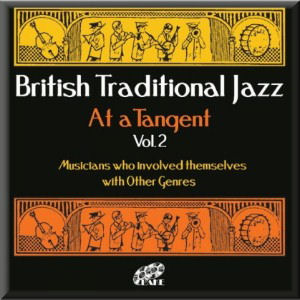The Diz Disley String Quintet
Between The Devil and The Deep Blue Sea
Crying the Blues
The Bob Clark Quintet
Exactly Like You
Ken Colyer with Little Brother Montgomery
Buddy Bolden's Blues
I Aint Gonna Give Nobody None of My Jelly Roll
Just The Blues
Bruce Turner with The Ken Sykora Guitar Club
Autumn Leaves
Bruce Turner with Big Bill Broonzy
Southbound Train
It Feels So Good
The Original Barnstormers Spasm Band
Shine
Whistling Rufus
Alexis Korner
Doggone My Good Luck Soul
Trouble in Mind
Alexis Korner's Blues Incorporated
Go Down Sunshine
Sandy Brown with Alan Lomax and The Ramblers
Oh Lula
Railroad Man
Sandy Brown with Johnny Duncan and The Bluegrass Boys
St James Infirmary Blues
Moanin' the Blues
Sandy Brown with Rambling Jack Elliott
Waiting for A Train
Whippin' That Old T B
Chris Barber and The Eagle Brass Band
Can't Buy Me Love/I Wanna Be Your Man
The Temperance Seven with Peter Sellers
Ukulele Lady
George Chisholm with The Goons
The Ying Tong Song
Recorded 1955-65 [79:09]
,
This is the second in Lake's series of supplements to its triple-CD release called British Traditional Jazz, A Potted History. Whereas in that first volume the focus was `boundary extenders' here we are dealing with traditional players who took part in other genres, such as Gypsy Jazz, R'n'B, Skiffle, New Orleans Brass Bands and Comedy. Many of the tracks are rare: some have never before been released. As before, I make a plea for Lake to let us know these super-rarities, as it would be very helpful.
Lake has honoured Diz Disley's band in its own release, one I reviewed with interest. Here are another couple of tracks from the Django and Steph-influenced band. Disley plays electric guitar and someone takes a very Nat Gonella-fixated vocal on Between the Devil and The Deep Blue Sea. Disley had also played with violinist Bob Clark whom we hear with an unidentified rhythm section, conjecturally that of Humphrey Lyttelton's band. Clark's track is live from 1957 and I prefer his playing and tone to that of Disley's somewhat erratic Dick Powell. Clark has something of Michel Warlop's wildness about him.
These were examples of the Gypsy element in Lake's mission statement. Little Brother Montgomery, joined by Ken Colyer in 1960, takes us to Southern Blues and New Orleans Professors. Montgomery is firmly in the Jelly Roll Morton groove in these tracks, both playing and singing, and Colyer plays some quietly contemplative steady blues in Just the Blues. Thence we move to Bruce Turner, to whom a trio of tracks is devoted. The vast echo of Autumn Leaves defeats even Turner and guitarist Ken Sykora, another Django-saturated player. For Turner's other tracks he backs another great American guest, Big Bill Broonzy. It's good to hear anything of Broonzy but the band backing him hasn't much to do: a real shame as it included Jiver Hutchinson, Kenny Graham, Benny Green, Dill Jones, Jack Fallon and Phil Seamen.
The plurality of music to be heard at the time is further represented by the jolly Barnstormers Spasm Band, which is full of kazoo and harmonica with author and discographer Brian Rust happily wielding the washboard. Mover and shaker Alexis Korner is rightly here, both solo mining Blues tropes and with an early Blues Incorporated with Cyril Davies in 1958. A more grey area is that exemplified by the meeting of the clans that saw Sandy Brown join folklorist Alan Lomax and Peggy Seeger and the Ramblers: Ewan MacColl and Shirley Collins are singing too. I enjoyed it, but purists at the time doubtless wouldn't. Brown has more opportunity to shine when he played alongside Johnny Duncan and the Bluegrass Boys. The recording is an echo chamber job and Duncan is pretty horrible but Brown takes a good obbligato and solo on St James Infirmary. Rambling Jack Elliott was a would-be country yodeller in the lineage of Jimmy Rogers and once again Brown keeps him close if relatively inconspicuous company.
Chris Barber and the Eagle Brass Band-an amusing typo calls it the Eagle Bass Band-were quick off the mark in 1965 by recording some Lennon and McCartney songs; Can't Buy Me Love and I Wanna Be Your Man are certainly raucous examples of the genre. Finally there are two favourites; The Temperance Seven with Peter Sellers playing Ukelele Lady and then, and Lake blushes even to write the title on its jewel box track listing, The Goons's The Ying Tong Song. Don't forget, however, that the booting `bone solo is by George `MacChisholm of the Steaming Kilt' Chisholm.
There's variety a-plenty in this fascinating programme. It serves a wider service, too, beyond collating what may superficially seem to be odds and sods. It shows that in the years concerned, traditionally minded players had the interest and skill to cross stylistic barriers. And in a time when barriers were very much the norm, when the binary poles of Modernism and Traditionalism were still entrenched, this inquisitiveness shows that perhaps some walls were more porous than others.
Jonathan Woolf
